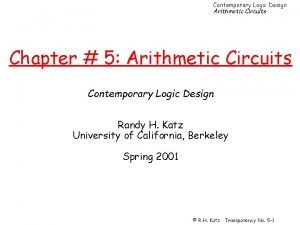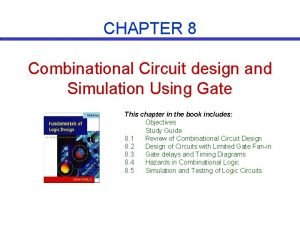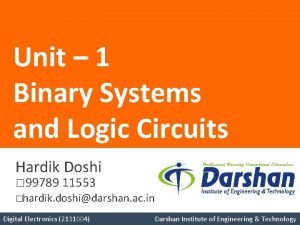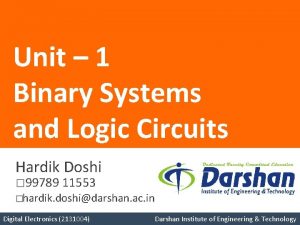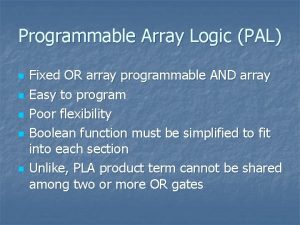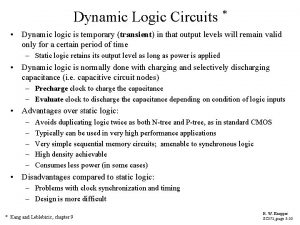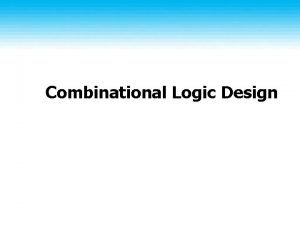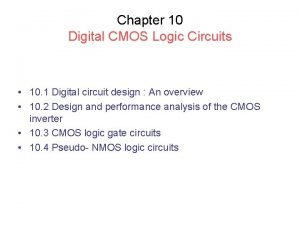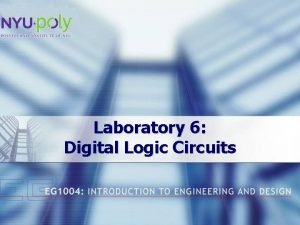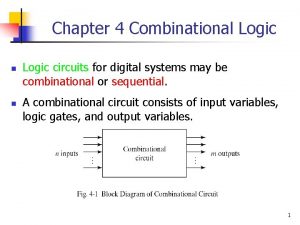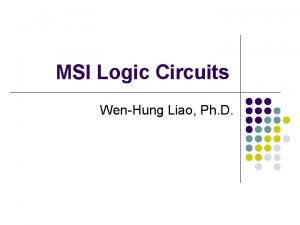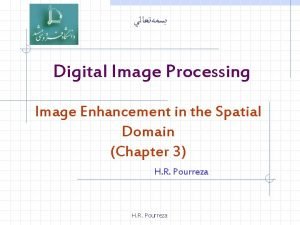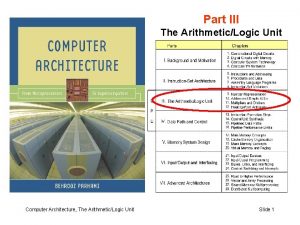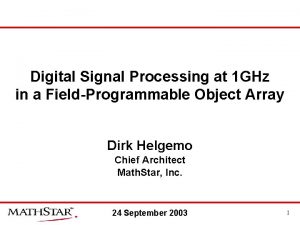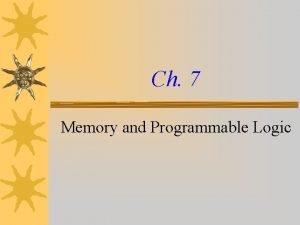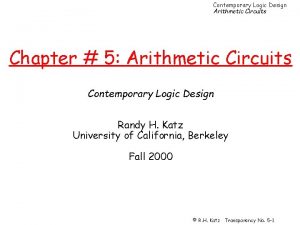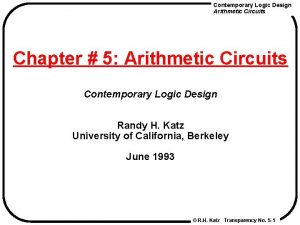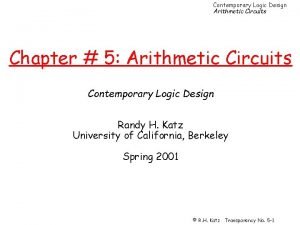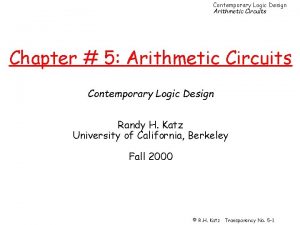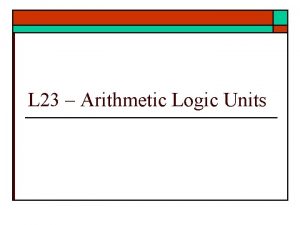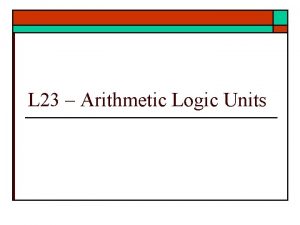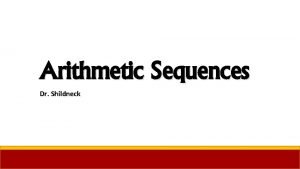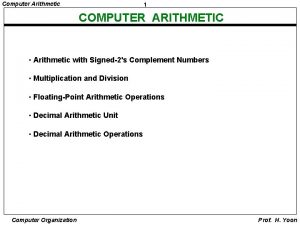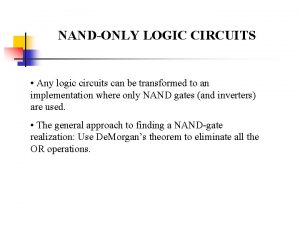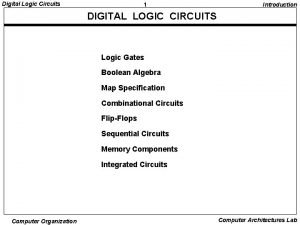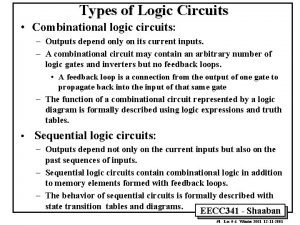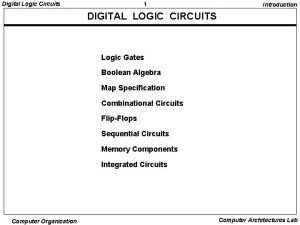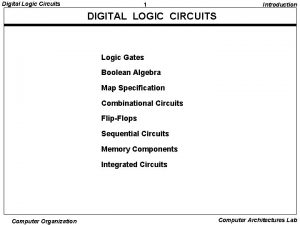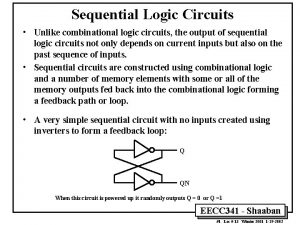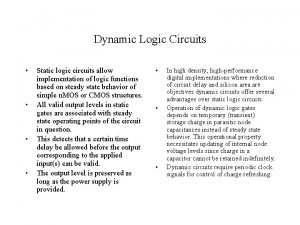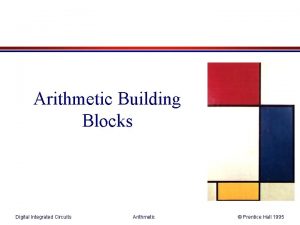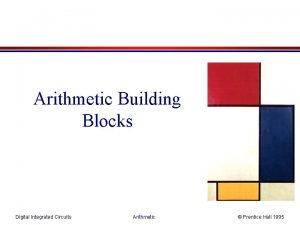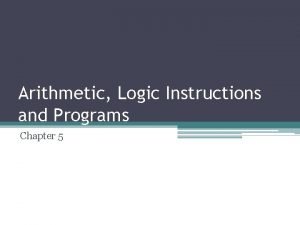Memory Memory The logic and arithmetic circuits weve


















































- Slides: 50

Memory

Memory • The logic and arithmetic circuits we’ve seen so far have no memory. They just transform input to output. • Can we make circuits that remember?

The Stubborn Guy • Matt really likes Sue, but he doesn’t like changing his mind… So: • Matt decides to go to the party if Sue decides to go OR if he (Matt) had already planned to go.

He Needs Feedback (from Himself) • Matt decides to go to the party if Sue decides to go OR if he (Matt) had already planned to go. • Two inputs to Matt’s decision: Sue, and his own state Sue OR Feedback Wire Matt

The Stubborn Guy: Feedback • Matt decides to go to the party if Sue decides to go OR if he (Matt) had already planned to go. Sue 1 OR • If Sue decides to go. . . Matt

The Stubborn Guy: Feedback • Matt decides to go to the party if Sue decides to go OR if he (Matt) had already planned to go. Sue 1 OR 1 • If Sue decides to go, Matt will go. 1 Matt

The Stubborn Guy: Feedback • Matt decides to go to the party if Sue decides to go OR if he (Matt) had already planned to go. Sue 0 OR 1 • If Sue changes her mind… 1 Matt

The Stubborn Guy: Feedback • Matt decides to go to the party if Sue decides to go OR if he (Matt) had already planned to go. Sue 0 OR 1 Matt 1 • • If Sue changes her mind, Matt will still go! Once he decides to go, we can’t get him to change his mind

Enter Rita • Matt doesn’t like Rita • Matt decides to go to the party if Sue decides to go OR: • If he (Matt) had already planned to go AND Rita decides NOT to go.

Enter Rita • Matt doesn’t like Rita • Matt decides to go to the party if Sue decides to go OR: • If he (Matt) had already planned to go AND Rita decides NOT to go. Sue OR Rita AND Feedback Wire Matt

Enter Rita • Matt doesn’t like Rita • Matt decides to go to the party if Sue decides to go OR: • Sue If he (Matt) had already planned to go AND Rita decides NOT to go. 0 OR 1 Rita 0 AND 0 0 0 Matt

Enter Rita • Matt doesn’t like Rita • Matt decides to go to the party if Sue decides to go OR: • Sue If he (Matt) had already planned to go AND Rita decides NOT to go. 1 OR 1 Rita 0 AND 0 0 0 Matt

Enter Rita • Matt doesn’t like Rita • Matt decides to go to the party if Sue decides to go OR: • Sue If he (Matt) had already planned to go AND Rita decides NOT to go. 1 OR 1 Rita 0 AND 1 1 1 Matt

Enter Rita • Matt doesn’t like Rita • Matt decides to go to the party if Sue decides to go OR: • Sue If he (Matt) had already planned to go AND Rita decides NOT to go. 0 OR 1 Rita 0 AND 1 1 1 Matt

Enter Rita • Matt doesn’t like Rita • Matt decides to go to the party if Sue decides to go OR: • If he (Matt) had already planned to go AND Rita decides NOT to go. Sue 0 – nothing changes: Sue can make Matt go, but cannot make him not go 1 Matt OR 1 Rita 0 AND 1 1

Enter Rita • Matt doesn’t like Rita (maybe together they can make him not go) • Matt decides to go to the party if Sue decides to go OR: • Sue If he (Matt) had already planned to go AND Rita decides NOT to go. 0 OR 1 Rita 1 AND 1 1 1 Matt

Enter Rita • Matt doesn’t like Rita • Matt decides to go to the party if Sue decides to go OR: • Sue If he (Matt) had already planned to go AND Rita decides NOT to go. 0 OR 0 Rita 1 AND 1 1 1 Matt

Enter Rita • Matt doesn’t like Rita • Matt decides to go to the party if Sue decides to go OR: • Sue If he (Matt) had already planned to go AND Rita decides NOT to go. 0 OR 0 Rita 1 AND 1 0 1 Matt

Enter Rita • Matt doesn’t like Rita • Matt decides to go to the party if Sue decides to go OR: • Sue If he (Matt) had already planned to go AND Rita decides NOT to go. 0 OR 0 Rita 1 AND 1 0 0 Matt

Enter Rita • Matt doesn’t like Rita • Matt decides to go to the party if Sue decides to go OR: • Sue If he (Matt) had already planned to go AND Rita decides NOT to go. 0 OR 0 Rita 1 AND 0 0 0 Matt

Enter Rita • Matt doesn’t like Rita • Matt decides to go to the party if Sue decides to go OR: • Sue If he (Matt) had already planned to go AND Rita decides NOT to go. 0 OR 0 Rita 0 AND 0 0 0 Matt

Enter Rita • Matt doesn’t like Rita • Matt decides to go to the party if Sue decides to go OR: • Sue If he (Matt) had already planned to go AND Rita decides NOT to go. 0 OR 1 Rita 0 - no change AND 0 0 0 Matt

What Sue and Rita Can Do • Sue can make Matt go, but cannot make him not go • Rita can make Matt not go, but cannot make him go

The (SR) Flip-Flop Set OR Reset M AND • M becomes 1 if Set is turned on • M becomes 0 if Reset is turned on • Otherwise (if both are 0), M just remembers its value

The Flip-Flop S M R • M becomes 1 if Set is turned on • M becomes 0 if Reset is turned on • Otherwise (if both are 0), M just remembers its value

What We Really Want D M W • Nothing happens unless Write = 1 • If Write = 1, then M becomes set to D • Once Write = 0 again, M just keeps its value. (It ignores D. ) • So, to set M to a value and store it as long as desired, set D to that value, then set W to 1 and then back to 0

The Data Flip-Flop AND D Write M AND • S Nothing happens unless Write = 1 R

The Data Flip-Flop AND D S Write M AND R • Nothing happens unless Write = 1 • If Write = 1, then M becomes set to D • Once Write = 0 again, M just keeps its value. (It ignores D. )

Using a Data Flip-Flop AND D Write S 0 M AND • 0 Initially, Write = 0. Let’s say M = 1. 0 R 1

Using a Data Flip-Flop AND D 0 Write 0 S 0 M AND 1 • Initially, Write = 0. Let’s say M = 1. • First, set D to desired value, say 0. 0 R 1

Using a Data Flip-Flop AND D 0 Write 0 S 1 M AND 1 • Initially, Write = 0. Let’s say M = 1. • First, set D to desired value, say 0. • Then, set Write to 1. 1 R 1

Using a Data Flip-Flop AND D 0 Write 0 S 1 M AND 1 1 • Initially, Write = 0. Let’s say M = 1. • First, set D to desired value, say 0. • Then, set Write to 1. • This causes M to be reset to 0. • Note use of abstraction with regard to SR flip-flop R 0

Using a Data Flip-Flop AND D ? Write 0 S 0 M AND 0 1 • Initially, Write = 0. Let’s say M = 1. • First, set D to desired value, say 0. • Then, set Write to 1. • This causes M to be reset to 0. • Finally set Write back to 0. Now D is irrelevant. R 0

The Data Flip-Flop D M Write • If Write = 0, M just keeps its value. (It ignores D. ) • If Write = 1, then M becomes set to D

Are We Done?

A Subtle Problem D M Write • When Write = 1, then M = D. • If we have some feedback between M and D, then circuit could go haywire. ? ?

A Subtle Problem ? D M 1 ? NOT Write • For example, suppose a NOT gate connects M and D. • When Write = 1, M and D keep changing. We have no control.

A Subtle Problem ? D M 1 ? NOT Write • We want to control the feedback, so that each time we set Write to 1 and then back to 0, M stores only the last value of D • (In this case, M should invert itself once each time we set Write to 1 and back to 0)

The “Airlock” Flip-Flop “Outer door” D Write • D 0 W 0 M 0 “Inner door” D 1 M W 1 Two-Stage System to prevent D ever passing through directly to M (W 0, W 1 connected by NOT, so never 1 at the same time)

The “Airlock” Flip-Flop “Outer door” D Write D 0 M 0 W 0 “Inner door” D 1 M W 1 • We start with Write = 0. • Let’s say D is always NOT M; i. e. connected by NOT gate. Start with D = 0, M = 1.

The “Airlock” Flip-Flop “Outer door” D 0 Write 0 D 0 M 0 W 0 “Inner door” 1 D 1 1 M W 1 • We start with Write = 0. • Let’s say D is always NOT M; i. e. connected by NOT gate Start with D = 0, M = 1.

The “Airlock” Flip-Flop “Outer door” D 0 Write 1 D 0 M 0 W 0 • Want to store D in memory. • Set Write to 1 “Inner door” 1 D 1 0 W 1 M 1 1 M

The “Airlock” Flip-Flop “Outer door” D 0 Write 1 • • D 0 W 0 M 0 “Inner door” 0 D 1 0 W 1 Want to store D in memory. Set Write to 1 “Outer” flip-flop sets M 0 = D 0 = 0 “Inner” flip-flop ignores D 1 since W 1 = 0 M 1 1 M

The “Airlock” Flip-Flop “Outer door” D 0 Write 0 • D 0 M 0 W 0 Now, set Write back to 0 “Inner door” 0 D 1 1 W 1 M 1 1 M

The “Airlock” Flip-Flop “Outer door” D 0 Write 0 D 0 M 0 W 0 “Inner door” 0 D 1 1 W 1 • Now, set Write back to 0 • Now “Inner” flip-flop sets M = D 1 = 0 M 1 0 M

The “Airlock” Flip-Flop “Outer door” D 1 Write 0 D 0 W 0 M 0 “Inner door” 0 D 1 1 M 1 0 M W 1 • Because of feedback, D might change to (NOT M) , which is 1 • But Write = 0, so “Outer” flip-flop ignores D, so M 0 stays 0.

The “Airlock” Flip-Flop “Outer door” D 1 Write 0 D 0 W 0 M 0 “Inner door” 0 D 1 1 M 1 0 W 1 • So memory does not change until we “toggle” Write. • (“toggle” means change from 0 to 1 or vice versa) M

The “Airlock” Flip-Flop “Outer door” D Write • D 0 M 0 W 0 This is Real Memory! “Inner door” D 1 W 1 M

Memory “Register”: 4 bits Data 1 D M W Data 2 D M W Data 3 D M W Data 4 Write D W M

Review • We have used the Universal method to build – ALU – Memory • Next steps – State machines to computer with memory – Building the computer – Writing a program to use the computer
 Virtualmemory
Virtualmemory We've a story to tell to the nations
We've a story to tell to the nations Weve been lied to
Weve been lied to Weve got the beat
Weve got the beat Weve got this
Weve got this Current in a parallel circuit
Current in a parallel circuit Arithmetic circuits
Arithmetic circuits Combinational circuit design
Combinational circuit design 2057 octal to decimal
2057 octal to decimal Binary systems and logic circuits
Binary systems and logic circuits Symbolic microinstruction
Symbolic microinstruction Programmable array logic circuit
Programmable array logic circuit Dynamic nand gate
Dynamic nand gate Combinational logic circuits
Combinational logic circuits Nmos inverter
Nmos inverter Combinational logic circuits lab report
Combinational logic circuits lab report Minecraft logic gates
Minecraft logic gates Comparator truth table
Comparator truth table For a three variable combinational circuits m(1 4 7)=
For a three variable combinational circuits m(1 4 7)= Msi logic circuits
Msi logic circuits Combining spatial enhancement methods
Combining spatial enhancement methods The control unit of cpu
The control unit of cpu Arithmetic logic unit
Arithmetic logic unit First order logic vs propositional logic
First order logic vs propositional logic First order logic vs propositional logic
First order logic vs propositional logic Third order logic
Third order logic Concurrent vs sequential
Concurrent vs sequential Tw
Tw Software development plan
Software development plan Is it x y or y x
Is it x y or y x Combinational logic sequential logic 차이
Combinational logic sequential logic 차이 If x = 0 and y = 1, which output line is enabled?
If x = 0 and y = 1, which output line is enabled? Memory and programmable logic
Memory and programmable logic Internal memory and external memory
Internal memory and external memory Primary memory and secondary memory
Primary memory and secondary memory Virtual memory
Virtual memory Hát kết hợp bộ gõ cơ thể
Hát kết hợp bộ gõ cơ thể Frameset trong html5
Frameset trong html5 Bổ thể
Bổ thể Tỉ lệ cơ thể trẻ em
Tỉ lệ cơ thể trẻ em Chó sói
Chó sói Glasgow thang điểm
Glasgow thang điểm Chúa sống lại
Chúa sống lại Các môn thể thao bắt đầu bằng tiếng bóng
Các môn thể thao bắt đầu bằng tiếng bóng Thế nào là hệ số cao nhất
Thế nào là hệ số cao nhất Các châu lục và đại dương trên thế giới
Các châu lục và đại dương trên thế giới Công của trọng lực
Công của trọng lực Trời xanh đây là của chúng ta thể thơ
Trời xanh đây là của chúng ta thể thơ Cách giải mật thư tọa độ
Cách giải mật thư tọa độ 101012 bằng
101012 bằng độ dài liên kết
độ dài liên kết






